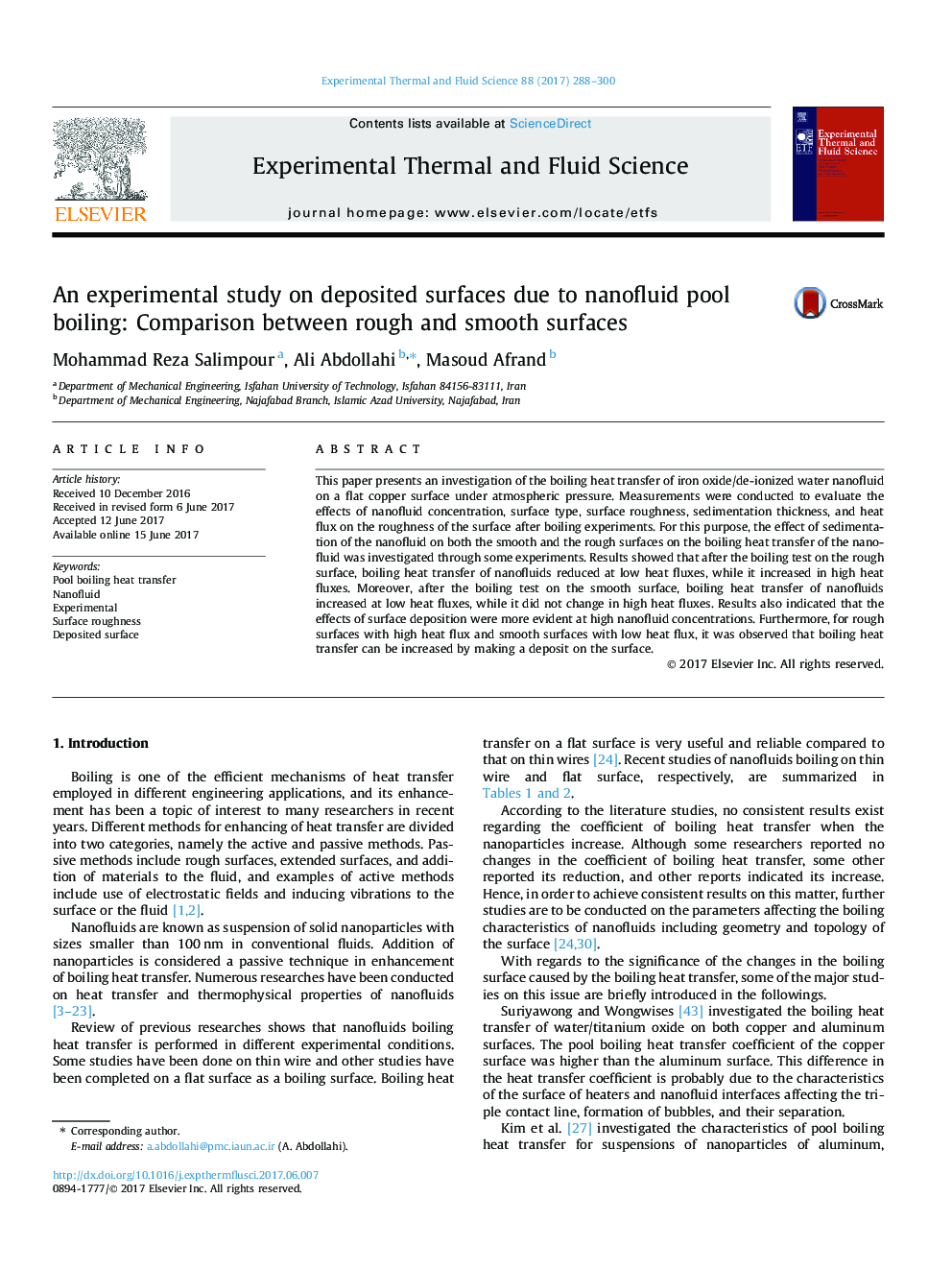| کد مقاله | کد نشریه | سال انتشار | مقاله انگلیسی | نسخه تمام متن |
|---|---|---|---|---|
| 4992585 | 1457388 | 2017 | 13 صفحه PDF | دانلود رایگان |
عنوان انگلیسی مقاله ISI
An experimental study on deposited surfaces due to nanofluid pool boiling: Comparison between rough and smooth surfaces
ترجمه فارسی عنوان
یک مطالعه تجربی بر روی سطوح رسوب شده به علت جوشاندن استحکام نانو فلوئید: مقایسه بین سطوح خشن و صاف
دانلود مقاله + سفارش ترجمه
دانلود مقاله ISI انگلیسی
رایگان برای ایرانیان
کلمات کلیدی
گرما انتقال گرما، نانو سیال، تجربی، زبری سطح، سطوح ذخیره شده
ترجمه چکیده
در این مقاله تحقیق در مورد انتقال حرارت حرارتی نانوفیلئید آب اکسید آهن / د یونیزه بر سطح مس مس تحت فشار اتمسفر انجام شده است. اندازه گیری ها جهت ارزیابی اثر غلظت نانوسیله، نوع سطح، زبری سطحی، ضخامت رسوب و شار حرارتی بر زبری سطح پس از آزمایش جوش انجام شد. برای این منظور، اثر رسوب نانوسیم در هر دو سطح صاف و خشن بر انتقال حرارت جوش نانو از طریق برخی آزمایش ها مورد بررسی قرار گرفت. نتایج نشان داد که پس از آزمون جوش بر روی سطح خشن، جوش انتقال حرارت از نانوسیم ها در شار حرارت پایین کاهش می یابد، در حالی که در جریان های گرمای زیاد افزایش می یابد. علاوه بر این، پس از آزمون جوش بر روی سطح صاف، جوش انتقال حرارت از نانوسیم ها در شار حرارت پایین افزایش می یابد، در حالی که آن را در شار حرارت بالا تغییر نمی کند. نتایج همچنین نشان داد که اثرات رسوب سطحی در غلظت نانو فلوئید بالا مشهود است. علاوه بر این، برای سطوح خشن با شار حرارت بالا و سطوح صاف با شار حرارتی کم، مشاهده شد که انتقال گرما جوش را می توان با ایجاد رسوب روی سطح افزایش داد.
موضوعات مرتبط
مهندسی و علوم پایه
مهندسی شیمی
جریان سیال و فرایندهای انتقال
چکیده انگلیسی
This paper presents an investigation of the boiling heat transfer of iron oxide/de-ionized water nanofluid on a flat copper surface under atmospheric pressure. Measurements were conducted to evaluate the effects of nanofluid concentration, surface type, surface roughness, sedimentation thickness, and heat flux on the roughness of the surface after boiling experiments. For this purpose, the effect of sedimentation of the nanofluid on both the smooth and the rough surfaces on the boiling heat transfer of the nanofluid was investigated through some experiments. Results showed that after the boiling test on the rough surface, boiling heat transfer of nanofluids reduced at low heat fluxes, while it increased in high heat fluxes. Moreover, after the boiling test on the smooth surface, boiling heat transfer of nanofluids increased at low heat fluxes, while it did not change in high heat fluxes. Results also indicated that the effects of surface deposition were more evident at high nanofluid concentrations. Furthermore, for rough surfaces with high heat flux and smooth surfaces with low heat flux, it was observed that boiling heat transfer can be increased by making a deposit on the surface.
ناشر
Database: Elsevier - ScienceDirect (ساینس دایرکت)
Journal: Experimental Thermal and Fluid Science - Volume 88, November 2017, Pages 288-300
Journal: Experimental Thermal and Fluid Science - Volume 88, November 2017, Pages 288-300
نویسندگان
Mohammad Reza Salimpour, Ali Abdollahi, Masoud Afrand,
